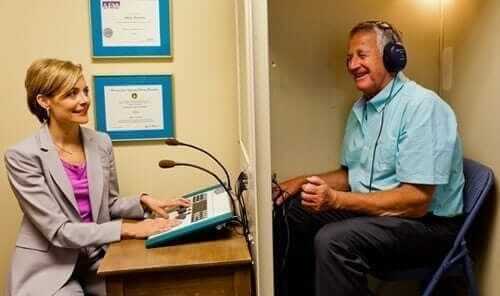Hearing Test
What To Expect During A Hearing Test
Hearing loss occurs when any part of your auditory system is not working as it should. Hearing loss can result from an issue in the outer ear, middle ear, inner ear, or even along the auditory nerve. Hearing loss can range from mild to profound and affects each individual differently.
There are four primary types of hearing loss: conductive hearing loss, sensorineural hearing loss, mixed hearing loss, and auditory neuropathy spectrum disorder. At Sound Relief, we can identify the specific type and cause of your hearing loss to develop a personalized hearing optimization plan that works for you, all from a simple audiologist consultation. A proper hearing loss diagnosis is the first step toward relief.
If you live with hearing loss, tinnitus, hyperacusis, or some other auditory issue, help will likely begin with a hearing test. Brief, comfortable, inexpensive, and straightforward, a hearing test provides your audiologist with valuable information and serves as an auditory health checkup. Comprehensive hearing examinations last 30 to 45 minutes for most adults, depending on the tests required. To take the first step toward improving your quality of life, schedule your appointment today.
Review of Hearing Health
To begin your hearing test, we review your personal information and health history. We will ask questions designed to learn more about your concerns. For instance, you may be asked about your symptoms, your history of noise exposure, your family’s history of hearing loss, and the specific types of environments in which you experience difficulty hearing. But, at any time during the hearing test, feel free to ask questions.
Physical Examination of the Ears
Your audiologist will conduct a physical examination of your ears. We use a video otoscope to see the eardrum and look for issues like earwax and/or infections.

Pure-Tone Test
Next is a pure-tone test. Usually and most effectively administered in a soundproof booth, this tone test determines the exact point, or “threshold,” at which you can hear various frequencies of sounds. We will place headphones over your ears that are attached to an audiometer, a device used to evaluate hearing acuity. This will transmit a series of tones at a variety of volumes into your ears. When you hear a sound, you will be asked to press a button – it’s as simple as that!
Speech Testing
Next, your audiologist will conduct speech testing. You will listen to a series of one- and two-syllable words at different volumes and then be asked to repeat them. This test hits two birds with one stone; not only will it determine the level at which you can detect speech, but it will also determine how well you understand speech. Depending on your specific situation, your audiologist may also wish to conduct a speech-in-noise test. This additional examination will establish how well you hear and understand speech in noise.
Audiogram
Your audiologist will record the results of your hearing test on an audiogram, which contains graphics to illustrate the type, pattern, and degree of your hearing loss. Together, you and your audiologist will review the information in detail. The audiogram will reflect your hearing loss in frequencies and decibels, and reveal the percentage of normal conversational speech that you are capable of hearing.
Your audiologist will make connections between the audiogram and your concerns about your hearing so that you can begin exploring treatment options. These may be anywhere from hyperacusis treatments to exploring hearing aid options, but each will be tailored to you and your needs.
When you leave the appointment, your understanding of your hearing health should lead to hope for the future. Using the latest developments in auditory research, state-of-the-art technology, and years of education and experience, our audiologists will find the most effective treatment that works for you.
Learn More
How Hearing Works | Online Hearing Quiz | Styles of Hearing Aids